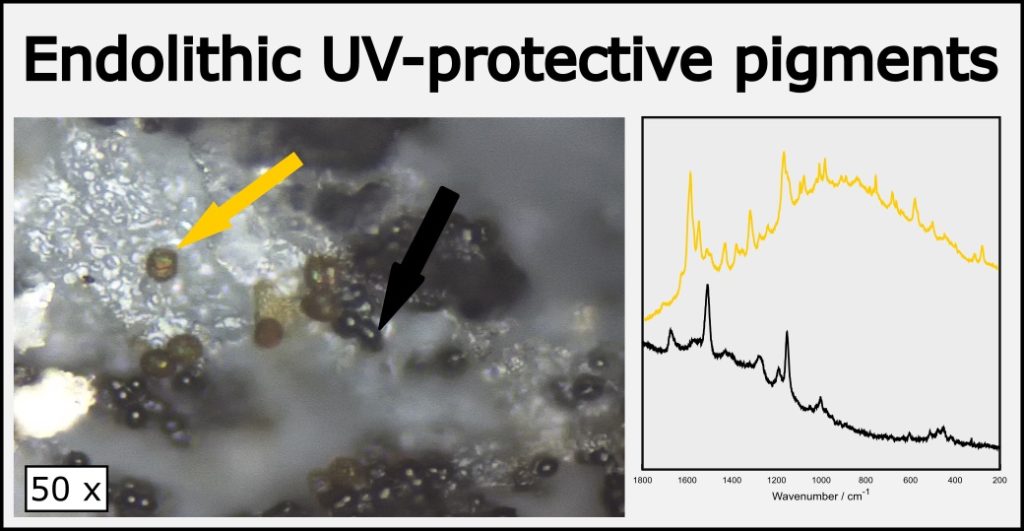
New paper reports groundbreaking findings on the distribution of non-carotenoid pigments in gypsum endoliths. In the study, Raman microspectrometry was used for analysis of UV-protective pigments of dark-pigmented endolithic colonizations in gypsum outcrops from Sicily, Poland and Israel. Colonized samples were investigated using 445-, 532- and 780-nm excitation lasers. Scytonemin and gloeocapsin were detected at all studied sites. Major Raman signatures of scytonemin were detected at 1593, 1552, 1438 and 1173 cm−1. Gloeocapsin shows characteristic Raman bands similar to anthraquinone-based parietin of lichens: at 1665, 1575, 1378, 1310 and 465 cm−1. Scytonemin and gloeocapsin are highly specific for cyanobacteria and can be thus used as biomarkers for certain taxa of cyanobacteria in geobiological and astrobiological studies. Detection of such pigments by Raman spectroscopy combining three excitation wavelengths allows gathering more information about the composition of endolithic consortia in their natural habitats using fast and non-invasive methods.
Němečková K., Culka A., Němec I., Edwards H. G. M., Mareš J., Jehlička J. (2021): Raman spectroscopic search for scytonemin and gloeocapsin in endolithic colonizations in large gypsum crystals. Journal of Raman Spectroscopy 52, 2633. (DOI)









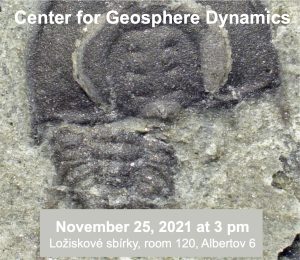 You are cordially invited to an autumn meeting of the Center with four lectures given by junior researchers. Save the date: 25th November 2021, at 3 pm in the Ložiskové sbírky room, Albertov 6. Program is available
You are cordially invited to an autumn meeting of the Center with four lectures given by junior researchers. Save the date: 25th November 2021, at 3 pm in the Ložiskové sbírky room, Albertov 6. Program is available  On Thursday 30th September 2021 Marek Tuhý successfully completed his PhD and defended his PhD thesis entitled “Wildfires in polluted areas: mineralogical transformations and remobilization of metal(loid)s“. The thesis was supervised by prof. Vojtěch Ettler and reviewed by Dr. Isabel Campos (University of Aveiro, Portugal) and Dr. Tomáš Navrátil (Institute of Geology, CAS). Marek will continue as a Junior Researcher affiliated with the Center for Geosphere Dynamics. Congratulations!
On Thursday 30th September 2021 Marek Tuhý successfully completed his PhD and defended his PhD thesis entitled “Wildfires in polluted areas: mineralogical transformations and remobilization of metal(loid)s“. The thesis was supervised by prof. Vojtěch Ettler and reviewed by Dr. Isabel Campos (University of Aveiro, Portugal) and Dr. Tomáš Navrátil (Institute of Geology, CAS). Marek will continue as a Junior Researcher affiliated with the Center for Geosphere Dynamics. Congratulations!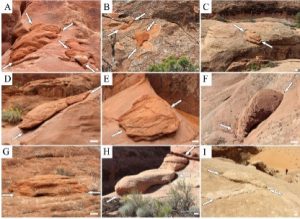 The article presents a new look on sandstone weathering/recession characterized by rapid disintegration of portions of the rock massif which are no longer physically connected with the main rock mass, though still in situ. A set of field and laboratory measurements testing mechanical and hydraulic properties of the rock were applied to compare the disconnected portions with those of the surrounding rock mass. Also, physical weathering experiments were performed to characterize the effect of confinement on the breakdown rate of several sandstone samples. The surfaces of disconnection follow bedding planes, planar elements of other sedimentary structures, subhorizontal fractures and stress shadows on subvertical cliff faces. Weathered surfaces of the disconnected portions show noticeably impaired mechanical properties, a faster capillary water absorption and a higher surface moisture compared to the much less weathered surfaces of the surrounding rock mass. Physical experiments demonstrated that a confinement by the surrounding rock mass may considerably delay the loosening of rock during weathering. The much faster disintegration rates of the disconnected portions of rock compared to their surroundings are explained by the fact that they are not confined and have a larger surface area.The recession rates of sandstone surfaces with disconnected portions are highly variable both in space and time and their genesis is demonstrated by two suggested conceptual models.
The article presents a new look on sandstone weathering/recession characterized by rapid disintegration of portions of the rock massif which are no longer physically connected with the main rock mass, though still in situ. A set of field and laboratory measurements testing mechanical and hydraulic properties of the rock were applied to compare the disconnected portions with those of the surrounding rock mass. Also, physical weathering experiments were performed to characterize the effect of confinement on the breakdown rate of several sandstone samples. The surfaces of disconnection follow bedding planes, planar elements of other sedimentary structures, subhorizontal fractures and stress shadows on subvertical cliff faces. Weathered surfaces of the disconnected portions show noticeably impaired mechanical properties, a faster capillary water absorption and a higher surface moisture compared to the much less weathered surfaces of the surrounding rock mass. Physical experiments demonstrated that a confinement by the surrounding rock mass may considerably delay the loosening of rock during weathering. The much faster disintegration rates of the disconnected portions of rock compared to their surroundings are explained by the fact that they are not confined and have a larger surface area.The recession rates of sandstone surfaces with disconnected portions are highly variable both in space and time and their genesis is demonstrated by two suggested conceptual models.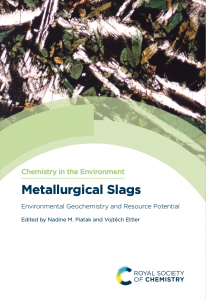 A new book entitled Metallurgical Slags: Environmental Geochemistry and Resource Potential edited by Nadine M. Piatak (USGS) and Vojtěch Ettler has been published by the prestigious publishing house, the Royal Society of Chemistry (
A new book entitled Metallurgical Slags: Environmental Geochemistry and Resource Potential edited by Nadine M. Piatak (USGS) and Vojtěch Ettler has been published by the prestigious publishing house, the Royal Society of Chemistry (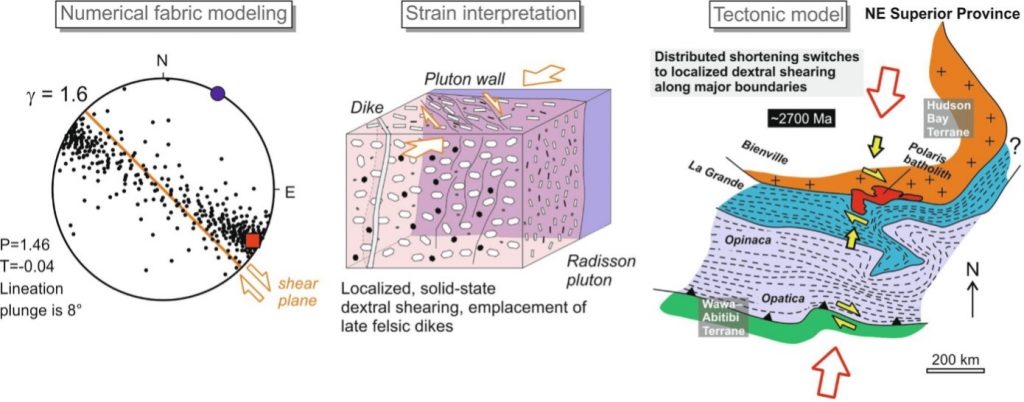
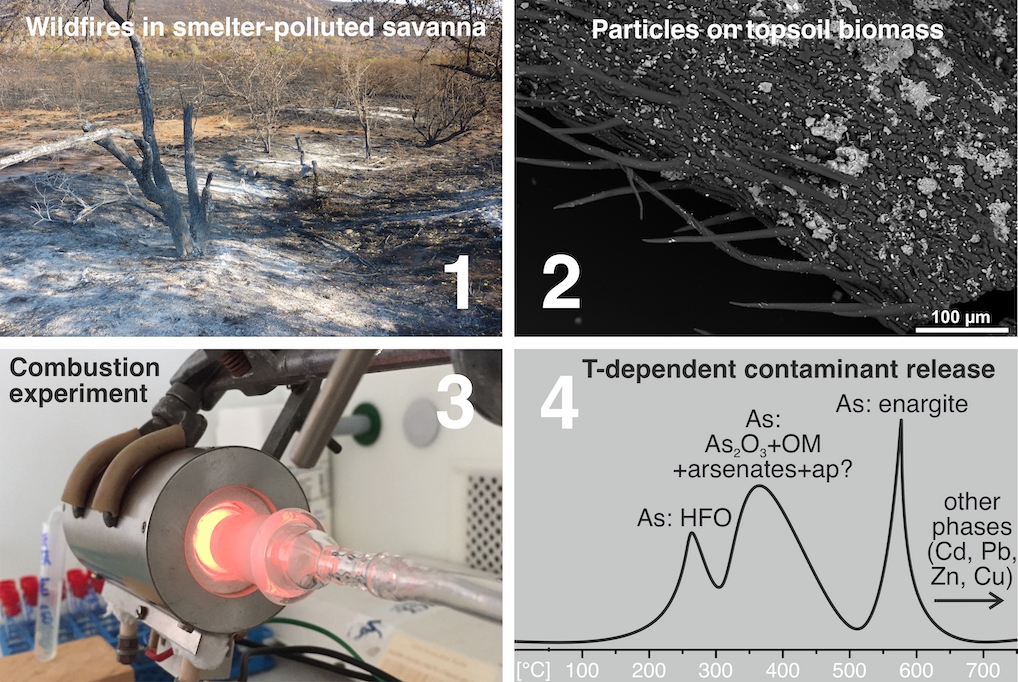 The temperature-dependent releases of metal(loid)s (As, Cd, Cu, Pb, Zn) from biomass-rich savanna soils collected near a Cu smelter in Namibia have been studied under simulated wildfire conditions. For this purpose, new wildfire-simulating setups were introduced. Laboratory single-step combustion experiments (250–850 °C) and experiments with a continuous temperature increase and online ICP-OES detection (25–750 °C) were coupled with mineralogical investigations of the soils, ashes, and aerosols. The results indicate that metals are dominantly concentrating in the ash residue, and part of As is remobilized depending on temperature. Therefore, the active and abandoned mining and smelting sites, especially those highly enriched in As, should be protected against wildfires, which can be responsible for substantial As re-emissions.
The temperature-dependent releases of metal(loid)s (As, Cd, Cu, Pb, Zn) from biomass-rich savanna soils collected near a Cu smelter in Namibia have been studied under simulated wildfire conditions. For this purpose, new wildfire-simulating setups were introduced. Laboratory single-step combustion experiments (250–850 °C) and experiments with a continuous temperature increase and online ICP-OES detection (25–750 °C) were coupled with mineralogical investigations of the soils, ashes, and aerosols. The results indicate that metals are dominantly concentrating in the ash residue, and part of As is remobilized depending on temperature. Therefore, the active and abandoned mining and smelting sites, especially those highly enriched in As, should be protected against wildfires, which can be responsible for substantial As re-emissions.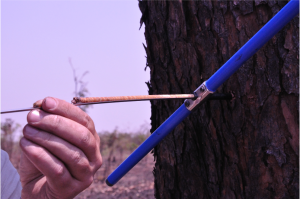 We used pine tree rings and soil geochemistry to expose the activity of a Pb-Zn smelter in Kabwe, Zambia. We found that local soils are extremely contaminated (up to 16000 mg/kg Pb; 14000 mg/kg Zn; 600 mg/kg Cu in the topsoil). Also, metal bearing particles share their Pb isotopic signature with smelting by-products, and more concerning, metals in tree biomass. We concluded that these metals enter the tree though the bark and leaves, not the roots, implying airborne contamination. Using Pb and C isotopes we mapped the dendrochronology of the tree and verified its susceptibility to changes in smelter production throughout the late 20th century.
We used pine tree rings and soil geochemistry to expose the activity of a Pb-Zn smelter in Kabwe, Zambia. We found that local soils are extremely contaminated (up to 16000 mg/kg Pb; 14000 mg/kg Zn; 600 mg/kg Cu in the topsoil). Also, metal bearing particles share their Pb isotopic signature with smelting by-products, and more concerning, metals in tree biomass. We concluded that these metals enter the tree though the bark and leaves, not the roots, implying airborne contamination. Using Pb and C isotopes we mapped the dendrochronology of the tree and verified its susceptibility to changes in smelter production throughout the late 20th century.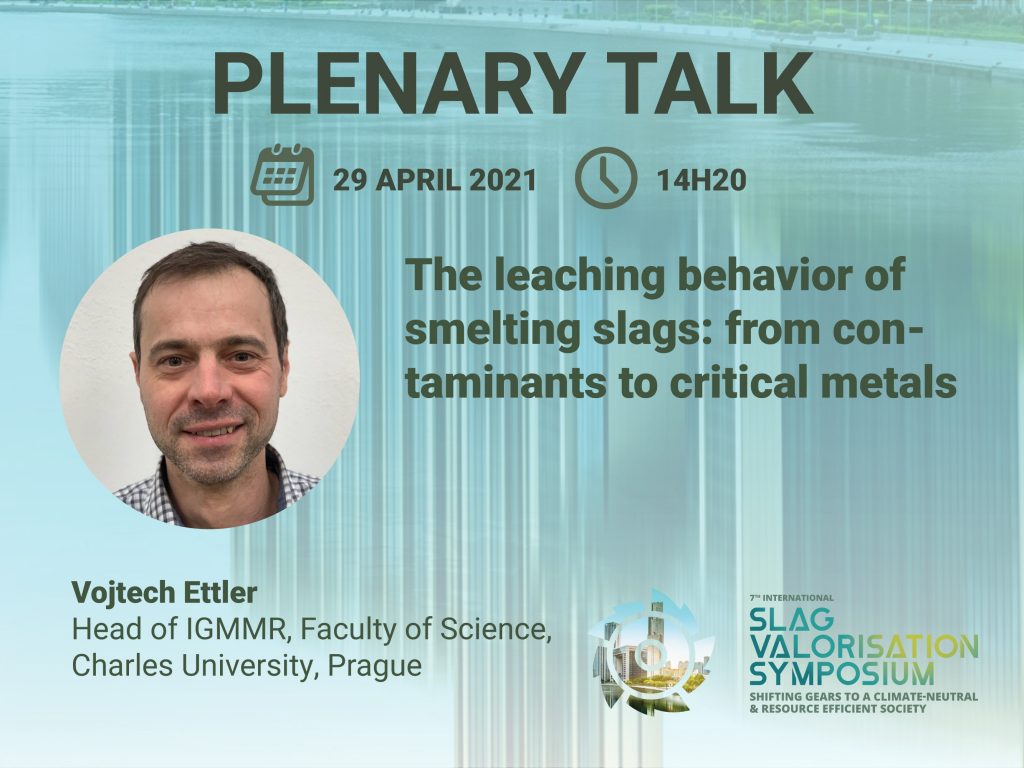 Vojtěch Ettler will give a plenary lecture entitled “The leaching behavior of smelting slags: from contaminants to critical metals” on the
Vojtěch Ettler will give a plenary lecture entitled “The leaching behavior of smelting slags: from contaminants to critical metals” on the 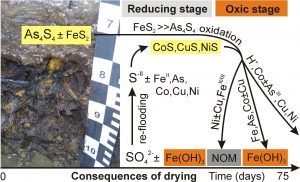 We combined selective chemical extractions and S isotopes to examine the mobility of As and trace metals (Co, Cu, Ni) in two Czech wetland soils enriched in authigenic Fe-As sulfide minerals through the drying process. We found that As and trace metals released via oxidation of the sulfide phases (particularly Fe sulfides) were almost entirely sequestered by Fe(III) (oxyhydr)oxides, but concomitant acidification resulted in the pH-dependent release of the As(III) and trace metals. Although our results documented the relatively low As mobilization potential under relatively short droughts (several weeks), the preservation of the anoxic conditions must be regarded as a fundamental management strategy of these and other sulfidic wetlands enriched in As.
We combined selective chemical extractions and S isotopes to examine the mobility of As and trace metals (Co, Cu, Ni) in two Czech wetland soils enriched in authigenic Fe-As sulfide minerals through the drying process. We found that As and trace metals released via oxidation of the sulfide phases (particularly Fe sulfides) were almost entirely sequestered by Fe(III) (oxyhydr)oxides, but concomitant acidification resulted in the pH-dependent release of the As(III) and trace metals. Although our results documented the relatively low As mobilization potential under relatively short droughts (several weeks), the preservation of the anoxic conditions must be regarded as a fundamental management strategy of these and other sulfidic wetlands enriched in As.